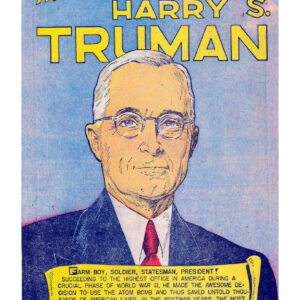It’s a fundamental fact: You can’t take gimmicks out of presidential politics. Because like it or not, gimmicks work.
One of the all-time greats was in 1840. A newspaper snidely editorialized about William Henry Harrison, “Give him a barrel of hard cider, and … a pension of two thousand [dollars] a year … and he will sit the remainder of his days in his log cabin.”
Democrats pounced on a golden opportunity to rebrand the slightly aristocratic Harrison as a sort of frontier Everyman. They featured log cabins at their rallies and passed out hard apple cider drinks by the barrelful—though later generations eventually took a dim view of using alcohol as a vote-getter. It was enough to propel Harrison to a narrow victory.
Some 100 years later, another president was in serious political trouble. Maybe Democratic strategists remembered the log cabin campaign as they desperately fished for ideas to save Harry Truman’s floundering presidency. Because his reelection prospects were pegged somewhere between slim to none.
He had inherited the job when Franklin Roosevelt died. With the Cold War raging in Europe and countless headaches at home as the U.S. made the painful transition from wartime back to a peacetime economy, it seemed everyone was mad about something. And they all dumped their anger at Truman’s feet.
When the 1948 election rolled around, Truman’s Democratic Party fractured. The left didn’t think he was liberal enough and deserted to support former Vice President Henry Wallace’s Progressives. The right thought he was too liberal and went over to South Carolina Gov. Strom Thurmond’s Dixiecrats. On top of all that, New York’s popular Republican Gov. Tom Dewey was circling the White House the way sharks circle a sinking ship.
Desperate times call for desperate measures, they say. With almost no money and little left to lose, Truman famously campaigned by train from one end of the country to another. Too broke to rent big city auditoriums, he spoke from the back of a railroad car at dozens upon dozens of small towns from one end of the country to the other in his famous “Whistlestop Campaign.”
But the Democrats also did something else that, although equally revolutionary, is seldom remembered today.
They issued a campaign comic book.
No, seriously, they did.
America was experiencing what collectors now call the Golden Age of Comics just then. Comic heroes had joined the war effort during World War II, supporting the Allied cause so exuberantly that one even showed Captain America punching Adolf Hitler in the face. So, the Democratic National Committee tried to harness that appeal in its quest for votes. And it bet big on the idea.
Three million copies of “The Story of Harry S. Truman” were released in October 1948, just as the country’s attention was focusing on the upcoming election. Its 16 brightly-colored pages recounted Harry’s improbable rise from the small, whitewashed house in Lamar, Mo. where he was born in 1884 to his arrival at the White House in 1945.
Although the artwork is credited to M.W. Ater, we don’t know who wrote it. It’s possible the author wanted to keep his name out of sight. Because those 16 pages are filled with such dialogue gems as, “Y’know, that boy Harry sure plows a straight furrow.” “Yep. The straightest in the county!” Here’s another: “Bess, the boys at the Legion meeting tonight were talking about having me run for county judge… as a Democrat!” You get the idea.
Great literature, it wasn’t. But if you think this comic book was intended for children, think again. Remember, the minimum voting age in 1948 was 21. (It wouldn’t be lowered to 18 until 1971.) Nowhere does the comic say, “Hey Kids! Be sure to show this to your mom and dad and tell them to vote for Uncle Harry on November 2!”
This was a direct appeal to everyday Americans who didn’t read The New York Times. Simplistic, yes; but it also talked to them in words they understood with a message that was impossible to miss. Harry Truman, the one-time farmer turned war veteran turned failed small business owner turned local politician, had reached the very top. He knew what their lives were like because he was one of them. And they could always count on him to look out for them.
When the votes were counted that first Tuesday night in November 1948, Harry Truman had pulled off the greatest political comeback of the 20th century. It was close, but a win is a win.
And a now-forgotten funny book printed on cheap pulp paper had quietly helped make it happen.

